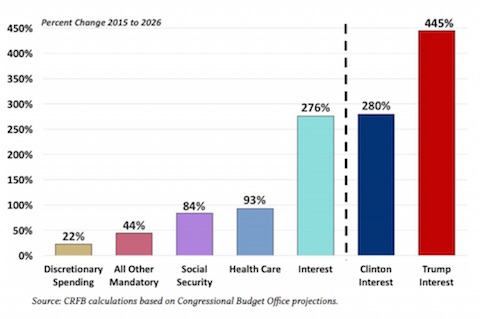Both Clinton and Trump Would Grow National Debt
Our national debt is at post-war record-high levels and projected to grow unsustainably. And neither former Secretary of State Hillary Clinton nor businessman Donald Trump would reverse course — Trump, in fact, would make our debt dramatically worse. That’s what we at the nonpartisan Committee for a Responsible Federal Budget found after a comprehensive fiscal analysis of the presidential campaign platforms of both candidates.
It’s encouraging that both Clinton and Trump have acknowledged the seriousness of our national debt. Trump has spoken repeatedly about the dangers of high debt and has called for a balanced budget. Clinton has emphasized the importance of paying for policy initiatives so as not to further increase the debt. But our new report, “Promises and Price Tags: A Fiscal Guide to the 2016 Election,” shows that both candidates would, in fact, add to the debt beyond what is currently projected under current law — Donald Trump, significantly so.
Specifically, we estimate that Clinton’s policies would increase the debt by $250 billion by 2026, while Trump would increase it by $11.5 trillion.
Clearly, Donald Trump’s policies would do far more damage. But it’s important to remember that debt is already scheduled to grow from today’s post-war record-high levels and neither candidate would stop it.
The result is that under Clinton’s plans, debt would grow from 75 percent of GDP today — it was half that before the great recession! — to 87 percent of GDP by 2026. Under Trump’s plans, debt would grow to a whopping 127 percent of GDP by 2026.

Source: Committee for a Committee for a Responsible Federal Budget
The reason that Clinton’s increase to the debt is relatively small is that her $1.45 trillion in new spending (on infrastructure, paid leave, and education) is mostly offset by $1.2 trillion in new revenue. Trump’s massive increase, on the other hand, is the net result of $10.5 trillion less in taxes, $650 billion less in primary spending, and $1.7 trillion in higher interest costs.
Interest on the debt is already the fastest growing part of the budget, and neither candidate would slow it down. Under Clinton’s policies, interest costs would rise 280 percent between 2015 and 2026; under Trump’s spending, interest would grow nearly 450 percent.
With rising payments on interest costs, an increasing share of our tax dollars will go toward financing the tax cuts and spending programs of the past, rather than the investments necessary to secure our future. This is true under current law, but it is especially true under the candidates’ plans.

Our estimates are, of course, subject to uncertainty. But there does not seem to be a plausible path for either candidate to put the debt on a sustainable path without modifying or adding to their plans.
With Clinton’s plans enacted, it would take $3.2 trillion of savings over 10 years to stabilize the debt-to-GDP ratio at today’s record-high levels. And more than $8 trillion would be needed to balance the budget. Trump, meanwhile, would need $14.4 trillion of savings to stabilize the debt and more than $19.3 trillion to balance the budget.
Neither candidate can reach those targets simply by growing the economy. For Clinton, 3 to 5 percent annual growth would be needed to put debt on a sustainable path. For Trump, 5 to 10 percent growth would necessary. For reference, more forecasters project closer to 2 percent growth — and the last time the country had a decade of 4 percent growth was almost half a century ago, when we benefited from much more favorable demographics.

Rather than hoping for magic levels of growth, the candidates — and especially Donald Trump — will need to propose a combination of spending cuts and new revenue to put the debt on a sustainable path. And with debt levels so high, they can’t afford to be taking things of the table for consideration.
Of course, no one wants to see one’s own taxes rise, benefits fall, or government services reduced. But no one wants to be drowning in debt either. It’s time the presidential candidates leveled with the American people about what it will take to keep us above water.
Marc Goldwein is the senior vice president of the Committee for a Responsible Federal Budget, a nonpartisan organization committed to educating the public about issues that have significant fiscal-policy impact. Click here to read CRFB’s “Promises and Price tags” paper.




